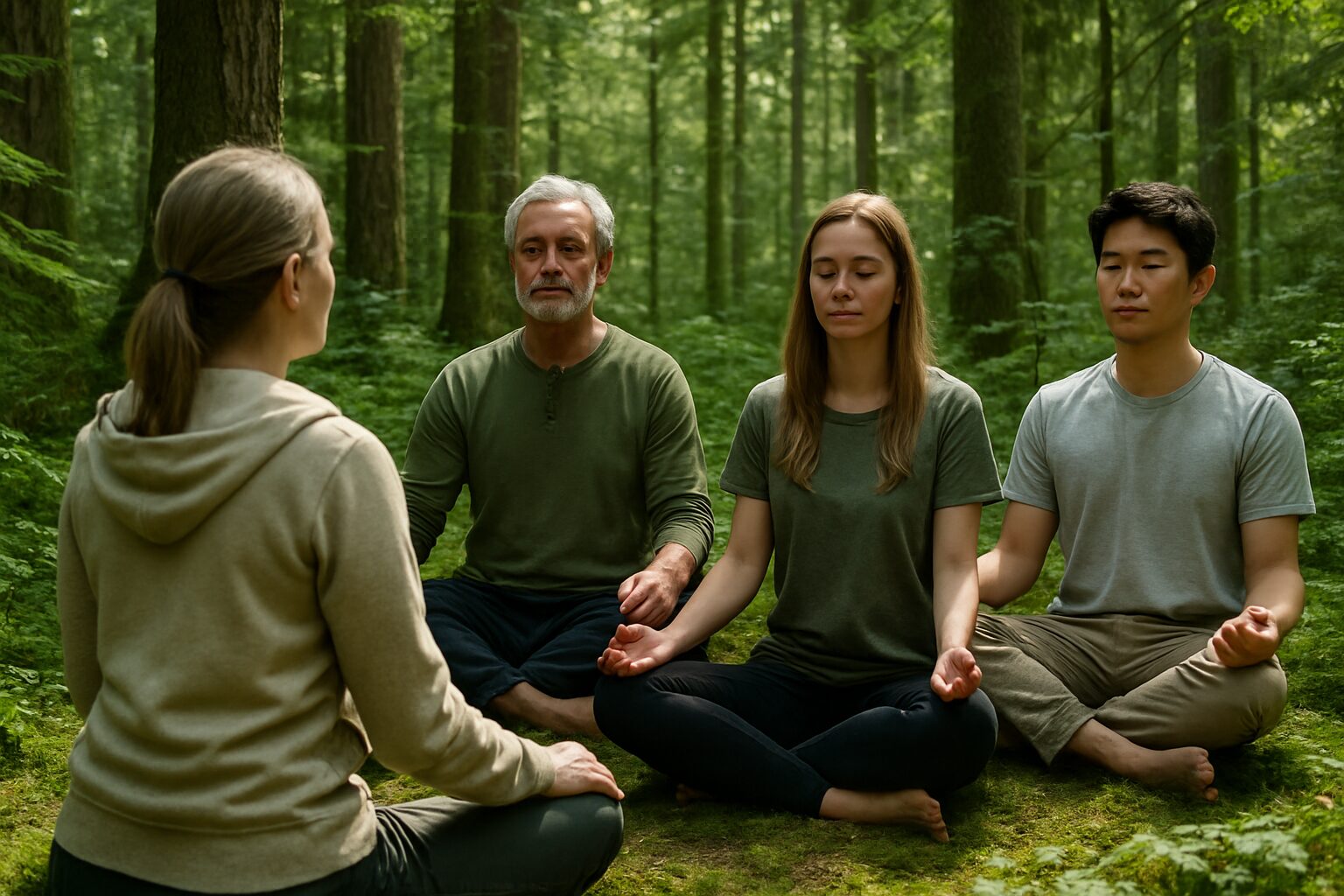In an era marked by relentless urban rhythms and escalating technology dependence, the pursuit of serenity has never been more urgent. Immersing oneself in natural environments offers more than just a scenic backdrop; it constitutes a profound journey toward mental tranquility and emotional balance. From the gentle sway of forest leaves along tranquil trails to the enduring embrace of ocean waves, nature’s retreats provide essential sanctuaries that nurture the spirit and restore cognitive vitality. This exploration unpacks the transformative effects of nature on serenity trips, illustrating how eco serenity and mindful adventures lead travelers to harmonious states of being, far beyond the transient pleasures of modern escapism.
Understanding the Biological and Psychological Foundations of Nature’s Serene Impact
Nature’s profound influence on mental well-being is anchored in both biological and psychological realms, offering a powerful antidote to the chronic stress prevalent in today’s fast-paced worlds. The reduction of cortisol, the body’s primary stress hormone, marks one of the most tangible biological effects when individuals engage in peaceful natural settings such as peaceful getaways along rivers or shaded woodlands.
One compelling biological pathway involves the modulation of the autonomic nervous system. Immersion in green and blue environments diminishes sympathetic nervous activity, which governs the ‘fight or flight’ response, and boosts parasympathetic activity – the system responsible for rest and digestion. This shift promotes not only reduced heart rate but also stabilization of blood pressure and an overall calming of physiological arousal.
Moreover, interactions with nature engage specific brain regions critical to emotional regulation and cognitive processing. Enhanced function of the prefrontal cortex during exposure to natural scenes improves one’s capacity to manage stress and fosters mental clarity. EEG studies reveal that alpha brainwave activity—closely associated with relaxation—increases when individuals absorb tranquil landscapes typical of serene escapes, further substantiating nature’s role in fostering mental calmness.
Psychologically, the Attention Restoration Theory (ART) elucidates how natural environments inherently capture involuntary attention through gently fascinating stimuli. This involuntary engagement allows directed attention to replenish, thereby counteracting the cognitive fatigue imposed by prolonged urban stressors. As a result, travelers on nature’s retreats often experience heightened focus and less mental exhaustion.
Beyond cognitive benefits, nature fulfills core psychological needs described in Self-Determination Theory—autonomy, competence, and relatedness—through experiences that grant personal mastery, meaningful connection, and a feeling of being part of a larger ecosystem. Evolutionarily ingrained to respond to natural settings with physiological calm, humans benefit from these ancestral connections, which facilitate deep emotional restoration during wilderness excursions.
- Key Biological Effects: Cortisol reduction, parasympathetic activation, enhanced prefrontal cortex and alpha wave activity
- Psychological Mechanisms: Attention restoration, fulfillment of autonomy and relatedness, emotional regulation
- Evolutionary Basis: Innate calming autonomic response to natural stimuli and environmental familiarity
For those planning serenity trips, appreciating these underpinnings encourages intentional engagement with natural surroundings, maximizing restorative outcomes. A well-chosen serenity trip destination harnesses these mechanisms, offering rich sensory and emotional experiences that support lasting inner peace.

Enhancing Mental Clarity and Creativity Through Eco Serenity and Mindful Adventures
Scientific research consistently reveals the potent effects natural environments exert on cognitive function and creative processes, integral components of a deeply fulfilling serenity trip. Immersive experiences within zen wilderness settings stimulate alpha brainwaves, which correlate with mental calmness and elevated creativity, fostering novel thought patterns crucial for problem-solving and mental resilience.
For example, controlled experiments frequently demonstrate that brief walks along tranquil trails lead to enhancements in working memory capacity and cognitive flexibility. These cognitive improvements derive from nature’s gentle fascination allowing the brain’s executive functions to recover from overstimulation common in urban landscapes. This restoration not only boosts clarity but also ignites novel ideation by encouraging lateral thinking free from distraction.
Neuroimaging studies confirm that viewing natural scenes activates the brain’s reward and emotion regulation circuits, enhancing positive affect and motivation. This engagement encourages prosocial behavior and fosters a sense of connectedness, crucial for emotional well-being during travel or retreats aimed at personal growth.
In practical terms, individuals seeking to deepen their connection with nature and nurture mental clarity can incorporate various strategies into their itinerary:
- Mindful Nature Walks: Walking deliberately through natural settings with heightened sensory attention to sound, smell, and sight enhances presence and mental stillness.
- Forest Bathing (Shinrin-yoku): Engaging all senses in a forest environment with an emphasis on tranquility reduces stress hormones and deepens emotional restoration.
- Journaling in Nature: Writing reflections while immersed in natural surroundings promotes emotional processing and novel insight.
- Creative Exploration: Using natural materials or sketching landscapes to stimulate creativity and foster mindfulness.
The role of nature walks in enhancing serenity practice elaborates on such approaches, sharing accessible ways to deepen nature connection for mental restoration on any outdoor trip.
The Therapeutic Power of Nature as a Complement to Mental Health Treatments on Serenity Vacations
As the understanding of holistic health expands, natural environments have become increasingly recognized for their therapeutic properties in mental health recovery and treatment. Serenity-oriented travel often incorporates these healing aspects, offering low-cost, accessible interventions that complement conventional therapy.
Many mental health programs integrate outdoor activities such as guided hikes, ecotherapy, or nature-based mindfulness practices. These leverage the restorative qualities of wild harmony to lower anxiety, depression, and PTSD symptoms. For example, veterans engaging in forest-based programs often report reduced stress and improved mood, supported by measurable decreases in cortisol and enhanced emotional resilience.
Engagement with nature simultaneously encourages social interaction through group activities including community gardening and conservation efforts. Such social bonding promotes emotional stability and fosters a sense of belonging, key factors in achieving long-term serenity.
Quality and accessibility of natural spaces are vital. Well-maintained parks or biodiverse wilderness areas integrated into travel itineraries offer vital sanctuaries for mental health maintenance and restoration. Incorporating sessions of outdoor meditation or animal-assisted therapy further amplifies therapeutic effects.
- Outdoor Ecotherapy: Guided nature immersion and conservation tasks promoting healing
- Mindfulness Practices: Meditation in natural settings facilitating emotional regulation
- Social Connection: Community gardening and group activities fostering belonging
- Wildlife Interaction: Therapeutic animal engagement reducing stress and enhancing mood
These nature-based interventions are increasingly embedded within mental health retreats, making them essential components of any serenity trip plan. Resources such as serenity trips focusing on mental health illustrate how these therapies fit seamlessly into holistic wellness journeys.

Nurturing Diverse Needs: Nature’s Healing Role Across Populations in Serene Getaways
Accessibility and inclusivity remain paramount in designing serenity trips that address the unique needs of diverse populations. From veterans and trauma survivors to children, seniors, and marginalized groups, exposure to nature provides tailored healing benefits.
For veterans recovering from trauma, immersion in calm haven natural settings reduces post-traumatic stress symptoms while fostering coping and resilience. Ecotherapy programs involving sustained wilderness exposure substantially support emotional regulation and community reconnection.
Children benefit profoundly from play and education in natural environments, observing improvements in concentration, creativity, and emotional self-regulation. Seniors engaging with gardening or gentle outdoor walks experience mood elevation and reduced social isolation.
Marginalized groups often face barriers accessing high-quality nature spaces. Designing inclusive peaceful getaways ensures equitable mental health benefits through accessible paths, sensory gardens, and community programs. Sensory engagement in these environments—touching, smelling, and listening—enhances emotional connection and psychological restoration.
- Veterans & Trauma Survivors: PTSD symptom reduction through hiking, ecotherapy, wilderness adventure
- Children: Improved attention and emotional growth via natural play and education
- Seniors: Enhanced mood and social engagement by gardening and nature walks
- Marginalized Groups: Inclusion and community bonding in accessible parks and green spaces
Ensuring the availability of these environments promotes healing, belonging, and purpose across demographics. Further reading on how serene travel places in 2025 cater to diverse needs exemplifies this vital commitment in the tourism sector.
Integrating Nature into Urban Life: Designing Calm Havens for Everyday Serenity Experiences
While serene escapes often involve remote wilderness, integrating nature into daily urban living is essential for sustained mental well-being. Accessible green and blue spaces provide vital refuges that attenuate urban stress and cultivate habitual mindfulness.
Studies underline that spending at least two hours weekly in parks, community gardens, or near aquatic environments significantly enhances mood, reduces anxiety, and lowers susceptibility to mental health disorders. Urban innovations like green roofs and pocket parks, designed for safety and inclusivity, allow city dwellers to engage in soothing nature experiences without leaving metropolitan boundaries.
Incorporating nature within educational and healthcare settings advances learning and healing. Schoolyards enriched with vegetation improve student attention, while hospital gardens accelerate patient recovery and decrease necessary medication for pain and stress.
- Design Features: Inclusive pathways, signage, seating to promote safe and welcoming access
- Environmental Benefits: Air purification, urban heat mitigation via green infrastructure
- Health Outcomes: Enhanced physical activity and mental restoration for diverse urban populations
- Community Building: Social cohesion fostered through group engagement in nature-based programs
Urban planning that prioritizes nature’s presence fosters calm havens within busier lives, supporting balanced mental health. The role of such environments is highlighted in guides on planning serenity trips incorporating urban nature experiences for maximum benefit.


As a 34-year-old Yoga Teacher, I am passionate about guiding others on their journey to mindfulness and well-being. With years of experience in various yoga styles, I create a welcoming environment that encourages personal growth and self-discovery. Join me in exploring the transformative power of yoga.


